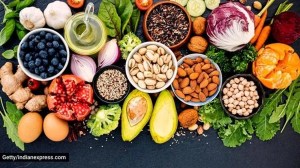- India
- International
The story of the humble bulb
As India tackles another onion price crisis, we trace its history of cultivation over 5,000 years and its inextricable link with the caste system in India
 The onions seem to have come into their own in upper class cuisine during the Mughal age. (Getty Images)
The onions seem to have come into their own in upper class cuisine during the Mughal age. (Getty Images)
Onions are known to be amongst the earliest food items cultivated by humankind. It has been cultivated for more than 5,000 years and there are doubts as to whether today it exists as a wild species. The exact place of the origin of the vegetable is not clear and researchers have ascribed onions to a region stretching from northwest India, parts of modern day Pakistan and Afghanistan in the west to parts of China and Central Asia in the northeast. One of the earliest recorded history of the vegetable dates back to the 4th BCE when labourers working on the famous pyramids in Egypt were fed onions to keep them in good strength. The Romans are known to have introduced the vegetable to different parts of Europe.
But the ancient world also had an ambivalent relationship to onions. In ancient Mesopotamia, writes the cultural geographer Fredrick J Simoons in Plants of Life, Plants of Death, though leeks and onions were freely eaten, they were banned in certain times of the year, especially during ritual occasions. Their pungent smells, propensity to introduce certain “baser sentiments” and supposedly aphrodisiac attributes gave the onions bad press in several parts of the world, including India.
But much of the onion story in India is inextricable with the caste system and gender-related restrictions. As the anthropologist Arjun Appadurai writes in a 1988 article in the Journal of the Comparative Study of Society and History, ‘How to make a national cuisine, Cookbooks in Contemporary India’, “Food taboos and prescriptions divide men from women, gods from humans, upper from lower castes, one sect from another”. Widows were especially prohibited from consuming onions. In early India, writes Simoons, onion “was banned to Brahmins and other respectable castes” who had to perform penance for violations. In the laws of Manu, notes the cultural geographer, onions, garlic and leek are unsuited for “eating by twice-born men”. The Vedic texts carry no mention of the onion. The moral dictums of the caste system played a big role in the rules of commensality and which food found a place within the folds of respectability. The 5th Century AD Chinese traveller to India, Fa Hsien writes in his memoirs “except for those who were scorned, few ate onions”.
It is not difficult to locate who were the ones scorned. In the laws of Manu, writes Simoons, “onions and garlic emerge from unclean things, which mean should a person eat them, he would be deemed an outcast.” Fa Hsien’s fellow countryman Hieun Tsang, who visited India about two centuries later, almost mirrors his predecessor’s observation on onions. “Very few people eat them. If anyone uses them for food, they are expelled beyond the walls of the town”.
Some ancient medicinal texts, however, acknowledge the benefits of onions. The Charaka Samhita, compiled between 2nd BCE and 3rd Century AD — and possibly contains wisdom from earlier era — extols the digestive properties of the onion. “The consumption of onion makes the man healthy, stout and energetic, his voice turns melodious and his skin becomes lustrous,” it notes, quoting a saying from an earlier age.

But moral prescriptions on food are often complicated by actual practices. The Manasollasa (literally refresher of the mind), one of the earliest Indian texts to pay attention to cooking, contains the usual proscriptions on onions. The writer, the Chalukyan king, Someswara, asks “kings to abstain from eating chicken, radish, garlic and onions”. Nevertheless, onions find a place in more than one recipe in the 12th-13th century text. “Pieces of meat are mixed with a paste of gram, grounded with spices and fried. To this are added tender hyacinth beans, onion and garlic,” notes one recipe.
Ibn Batuta, who visited India about a century after the Manasollasa was composed, notes in his Rihla that a favourite dish of the Muslim community in Kerala’s Malabar region was a lamb dish that had grated coconut and onion. The vegetable also finds a place in his mention of the royal meal. The Tughlak emperor, writes Batuta, “ate bread, which is thin round cakes, meat cooked with ghee, onions and green ginger, sambusak or triangular pastries made of hashed meat and cooked with almonds, pistachios, onions and spices put inside a piece of thin bread fried in ghee”.
In Curry, A Global History, food historian Lizzie Collingham writes, “By the time Babur conquered Hindustan, vegetarianism had become a powerful statement of one’s position in Indian society… Orthodox Brahmins avoided all foods which were thought to stimulate the passions. These included meat, onions and garlic.”
The onions seem to have come into their own in upper class cuisine during the Mughal age. The rice and meat dishes, kababs and kormas that became the hallmark of culinary culture of the court and the upper classes, were laced with onions. So did the Rajput cuisine of roast meats.
But what about the taboos on onion? Collingham has a vivid account. “Prakash Tandon observed the breakdown of caste restrictions in his own Punjabi Khatri family. Tandon’s father was a member of the educated Indian middle class. Tandon’s mother was a strict vegetarian, consequently her food was cooked separately. While she did not mind onions entering the kitchen, meat and fish were kept separately”.
Mahatma Gandhi’s writings have several references to onions as food for common people. In fact one of his earliest satyagrahas, in Kheda, was associated with onions. In his autobiography, The Story of My Experiments with Truth, the Mahatma writes that when the colonial state attached the properties of the Gujarat agriculturists, he asked them to “harvest their onion crops from fields which were wrongly attached”.
Gandhi, a Vaishnav himself, did not grow up an onion eater. But in England he took to the vegetable with gusto. He gave up onions in South Africa, only to advocate them for nutritive purposes on his return. In 1936, he wrote what many Indians think today, “I don’t know what the poor man will do without onions and garlic.” (Mahatma Gandhi, Collected Works, Volume 69).
Apr 25: Latest News
- 01
- 02
- 03
- 04
- 05







































